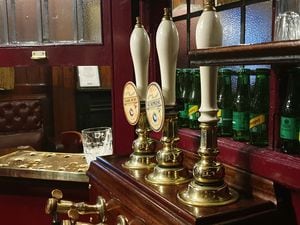The Falklands 40 years on: 'Worse things happen at sea' - hero Simon Weston
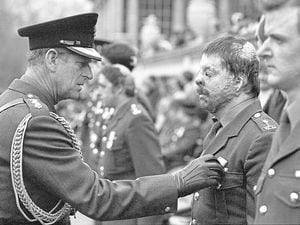
Peter Rhodes has met many Falklands veterans over the years. Here we reproduce interviews written by Peter 40 years ago.
Simon Weston is a symbol of the Falklands War. He survived but suffered 46 per cent burns. He is now a successful charity campaigner, author and TV personality, honoured with a CBE. He has also travelled to Argentina to meet the pilot who caused his injuries – they are now friends. He is happily married with three grown-up children and grandchildren.
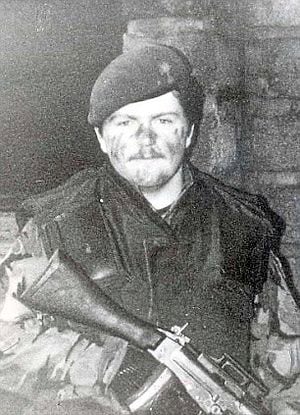
Back in December 1985, when interviewed by Peter Rhodes as a 24-year-old, Simon's physical and mental scars were still raw. This is that interview as he wrote it:
Simon Weston has a hangover. I sympathise.
“No, it’s my own fault,” he insists. “Too much Pils last night. Still, worse things happen at sea...”
It’s a line he clearly enjoys using. A blunt, throwaway phrase in lilting Welsh tones that hits you like a boot in the guts. For at sea, off the Falklands on June 10, 1982, Simon Weston’s world exploded in flames. Forty-two months on, he is looking back on 1985 as ‘the most fantastic year’ and forward to the New Year challenge of rebuilding his life. Hideously burned, his hands a cruel parody, he talks of his good fortune, good friends, wonderful village – and mum’s home-made gravy.
This year he was named one of 10 Men of the Year, sharing the honours with, among others, Terry Waite, the Archbishop of Canterbury’s special envoy.
“He’s a hell of a nice boy a really good bloke, know what I mean?”
I dare say Waite repays the compliment. For Simon Weston, the Welsh Guardsman whose wrecked face speaks for all the Falklands casualties, is emerging from his ordeal as a hell of a nice bloke.
“Bitter? How can I be bitter? That Argentinian pilot only did to me what I was going to do to him or his mates. That’s what war is all about.”
Simon lives with his mother, Pauline, who is a district nurse and his stepfather Harold ‘Lofty’ Hatfield, in Nelson, Mid-Glamorgan. It’s a neat, unpretentious community of miners and little shops, a place were people know their neighbours and Coal Board landscapers endlessly try to make slagheaps look like something else. Simon left here in 1977 to join the Welsh Guards, “more to keep out of trouble than anything. I was a big bloke; there was always the chance I might get in a fight, hit someone and get put away. I needed discipline.”

He got it. After passing out, Guardsman 24469434 Weston served with his battalion in Kenya, Northern Ireland, Germany and Berlin.
“Of course we never expected a shooting war. Who does? Honest to God, if you knew what was around every corner, you’d never do anything.”
When the Falklands were invaded, a Commando brigade was dispatched for the initial fighting. The Guards followed.
“They were going to send some other lot, some fish-and-chip bunch, but they weren’t good enough. So they sent us.”
Landed at Ajax Bay, the Guards were re-embarked on Sir Galahad for the move to Fitzroy. They arrived and waited. Whatever the experts say now, no-one then appreciated the hazards.
“In danger? Christ, we didn’t even realise we were at war. We were warm, dry and happy. We were still playing cards when it happened.”
Sir Galahad and its sister ship Sir Tristram were bombed by Argentinian jets. For a moment, Simon loses his bounce. It’s all been said. He doesn’t want to talk about it. Fifty-seven died at Fitzroy. Of Simon’s 30-strong mortar platoon, 22 were killed outright, seven maimed and one escaped without a scratch. His best friend, Andrew ‘Yorkie’ Walker was among the dead. By the normal rules of surgery Simon should have been, too. Burns covered 46 per cent of his body; 40 per cent is generally regarded as fatal. But the 16-stone mortar crewman was young, fit and strong. Despite his appalling injuries he got out of the inferno unaided. The medics operated at sea to save his eyes and poured pints of saline solution into his tortured body.
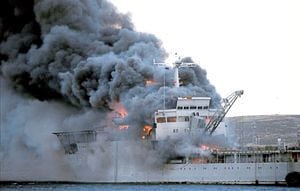
“Disgusting. All I could think of was a glass of Coca-Cola with ice in.”
Back home he underwent the first of 30-odd skin grafts. Astonishingly, he was fit enough to visit home for his 21st birthday less than two months after the tragedy. “The whole village put everything they could into it,” says his mother. “He received a gold watch and champagne and so many things for the house. And all he could say was ‘isn’t home-made gravy lovely?’.”
Healing takes time. With precious little skin to work with, the surgeons took grafts from his stomach and buttocks to repair his ravaged face. The operations will continue “until me or the surgeon says enough is enough. Honest, my body looks like a patchwork quilt under this,’’ he says, tugging his sweatshirt.
“Of course people stare and sometimes I get the rag out. If I’m upset I try to say something that will turn it round, embarrass them, not me.”
Since his injuries he has been an honoured guest of his former regiment. He laid the wreath at the Guards’ Memorial; he has met his former comrades in Germany and Belgium. Becoming a celebrity – “a minor celebrity” he insists – has made the process easier.
“I never know if they’re staring because they recognise me or just because of the way I look.”
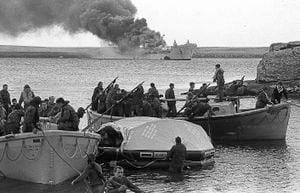
Smiling Sailor who is never forgotten
Falklands weather. The rain hammers down like shrapnel on the conservatory roof as Rose Anslow talks about “our beautiful boy”.
His laughing face smiles back from a treasured photo on the table at her Tettenhall home.
Adrian Anslow, a sailor of the Fleet Air Arm, was killed when the Atlantic Conveyor was attacked by Argentine warplanes in the Falklands war. He was 20.
“They always called him the Smiling Sailor, That’s how his friends remember him.”
She recalls April 1, 1982 when Adrian suddenly appeared on her doorstep to announce he was being posted to an unknown destination.
“I knew instinctively, and I told him so, that he was going off to war. He said, ‘Don’t worry, mum, I’m going to be lying under the palm trees’.”
Seven weeks later, there was another caller at the door.
Rose Anslow remembers “a man with a beard, looking very Royal Navy”.
He broke the news that Adrian was missing. A priest called. A doctor gave her a sedative. Much of what followed is a blur.
“Adrian was simply in the wrong place at the wrong time.”
Her sailor son, a helicopter-radio specialist, was one of the first into the war zone, flying to Ascension Island by RAF Hercules to join a fleet auxiliary.
After a spell on HMS Invincible he was part of a small naval party sent to the unarmed merchant ship, Atlantic Conveyor. On May 25, the Argentine air force attacked what they thought was one of the two British aircraft carriers.
In fact, the big blob on their radar screens was Atlantic Conveyor.
The ship was struck and set on fire by at least one Exocet missile and sank later. Twelve men, including Adrian Anslow and the ship’s skipper, Captain Ian North, were lost. Rose Anslow discovered years later that her son had been below decks at the time of the attack. She prays he died quickly.
Her son was a most unlikely warrior. Adrian was a lad of strong emotions, a lover of music fervently opposed to foxhunting and all forms of animal cruelty.
Adrian’s letters home as the fleet sailed to war told of his delight at seeing turtles at Ascension Island. Later, he was deeply moved by the plight of his enemy.
He took photographs of some Argentine prisoners-of-war, an encounter which made him physically sick.
In one of his later letters, he accepted the inevitable: “Things are now changing, Mum. The politicians are not talking. A lot of young men are going to die and, hopefully, I won’t be a hero.”
She says: “For some reason I didn’t feel he was in danger.
“I felt the people he was with would take good care of him.
“I remember hearing the news that a ship had been hit and 12 men lost. I got down on my knees and prayed for them. As far as I knew, Adrian was still on Invincible.
“The next day I somehow felt uneasy. Then, that evening, the doorbell went...”
Weird tinkling of the Belgrano sinking
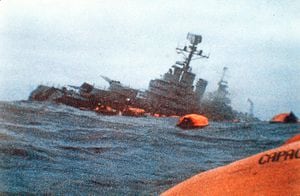
They had trained, trained and trained again. In May 1982, the crew of Her Majesty’s Submarine Conqueror were part of a silent, elite force. They were deep in the South Atlantic, tracking a warship whose name was soon to pass into history.
“None of us had been to war before,” says Steve McIntosh, “It was just like another exercise when we went to action stations.’
The submarine had been tracking the Argentinian cruiser General Belgrano for days. On board Conqueror, Steve was a 17-year-old contact evaluation plotter in the control room.
“All the information was getting relayed back to the Government in London. We did ask permission to engage her and we were knocked back several times.”
Finally, Whitehall authorised Belgrano’s destruction.
“We were carrying wire-guided torpedoes but we decided to use Mk 8s, the World War Two torpedo, fired in salvoes of three. We could hear everything. We could feel the submarine shake slightly as they were fired. We could hear them running for a while and then everything went silent. Then we heard two impacts. It was like a thud and a hollow clap, and a weird tinkling. That was the metal of the ship breaking up. There was also the smell of cordite coming back up the torpedo tubes.
“At first, the mood was fantastic. But when it sank in we thought, what have we done? Although we were at war, it wasn’t as though we thought about the enemy as people. The Belgrano was a big and very, very dangerous ship. We knew we had to disarm it, to make sure there was no confrontation with the Task Force.”
It became the most controversial event in the Falklands War. The Belgrano went down with the loss of 323 lives, the single biggest death toll of the campaign. A ferocious debate began and has never ended. Some claim the warship was heading away from the combat area and was no threat. Others argue that the Belgrano was the southern part of a pincer movement by the Argentinian navy which could have decimated the British fleet. One thing is certain. Once she was sunk, the Argentinian navy fled the seas for the rest of the war.
For Steve, the operation secured him a place in history. He has the distinction of being the first black sailor ever to have served on a Royal Navy submarine when it sank another vessel in war. He was following a family tradition. Born to Jamaican parents in Sedgley, he grew up in Bilston and was educated at Moseley Park School. His older brother David and twin brother Clive both served in submarines but Steve was the only one to see action.
After the May 2 attack on the Belgrano the British submarine went “fast and deep” to avoid the cruiser’s smaller escort ships.
“Later on there was a service on board. We prayed for those who had been left behind by their escorts. I thought it was a shame that people lost their lives but I still think it was either them or us. I felt sorry for their sailors because they were conscripts. No way were they as good as we were.”


